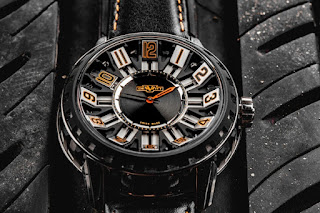DeWitt's playful hours!
Offers
Academia Slide
Dragging,
sliding, and now, toboggan-shaped: the creative hours of the DeWitt Manufacture
showcased on a new model, the highly original and playful Academia Slide.
Directly inspired by Jérôme De Witt's passion for cars, it bears witness to the
creative vitality of what remains one of the very last manufactures in Geneva
to be 100% independent and family-run.
Observation,
inspiration, a new timepiece is continuing its creative journey; the DeWitt
manufacture presents an original, unusual, playful new creation, the Academia
Slide.
Its
story began with Jérôme De Witt's desire to display the time differently. While
the manufacture has fully demonstrated its skill with traditional high-end
timepieces, the Academia collection also lends itself to particularly bold
creative exercises.
The
Slide is the latest illustration of this approach. Made entirely from titanium,
this 49 mm piece was originally inspired by children's toboggans. It presents a
progressive, effortless slide from top to bottom thanks to an intuitive use of
gravity. The Academia Slide applies this basic physical principle to
watchmaking in a ground-breaking way.
Every
hour is inscribed on a brass plate that slides along a track, guiding it to a
horizontal position. It is this horizontal display alone that shows the current
hour. Next, the two central hands indicate the minutes and seconds. This
simple, intuitive design is also highly energy efficient. The hour plates slide
in a natural, fluid manner.
They
are all interconnected: as soon as an hour arrives at the flat position, its
plate begins its return to a vertical position and the next plate begins its
descent. This continuous progression of the hours, which never freeze even
for
a second, symbolises the elusive, ephemeral nature of time.
The
unusual star-shaped dial is a direct result of Jérôme DeWitt's passion for
mechanics. The creative soul of the manufacture and passionate collector of
historic automotive developments was inspired here by the legendary rotary
engines central to vintage cars and aeroplanes from the early 20th century.
These
engines ran extremely smoothly thanks to their considerable inertia, a property
that is fully exploited in the Academia Slide. They were also more compact and
lightweight than other systems. Again, the Academia Slide takes full advantage
of this, offering a simpler watch construction of just 276 components, scarcely
more than a traditional three-hand manufacture movement.






Comments
Post a Comment